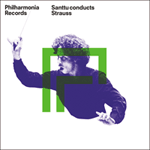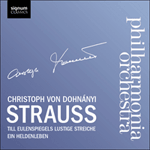
Welcome to Hyperion Records, an independent British classical label devoted to presenting high-quality recordings of music of all styles and from all periods from the twelfth century to the twenty-first.
Hyperion offers both CDs, and downloads in a number of formats. The site is also available in several languages.
Please use the dropdown buttons to set your preferred options, or use the checkbox to accept the defaults.

He called the work a Rondo. The form is a free adaptation of the classical A-B-A-C-A rondo form. Two themes, or fragments of theme, represent Till. The first is heard on the strings in the quiet opening under which Strauss in later years wrote the words ‘Once upon a time there was a roguish jester’. This is followed by a phrase on the horn (one of the most famous solo passages in the instrument’s repertoire) which, said Strauss, means ‘whose name was Till Eulenspiegel’. These two motifs unify and dominate the whole work. The second is built to a climax which shows Till in his full colours, cocking a snook on the shrill D clarinet. ‘He was a wicked goblin’, Strauss wrote under this phrase.
After this exposition there is a section portraying no particular incident. Strauss plays about with the themes, displaying a superb lightness of humour and touch, qualities which were not prevalent in German music of this date. The first episode begins with a flourish of clarinets and a cymbal smash. Till rides through the market square, scattering people and produce, and escapes (trombones) in the confusion, ‘off and away in seven-league boots’ (all these quoted descriptions are Strauss’s own). A pause. Till, concealed in a mouse-hole, warily looks to see if he is unobserved and cautiously (minor seconds) escapes into his next adventure.
‘Dressed as a cleric he oozes unction and morality’—this is Strauss’s description of the B section. Violas and bassoons have an appropriately ‘oozing’ theme. ‘The rogue peeps out’ on the D clarinet and there are further hints of the first Till motif. Suddenly (violin and muted brass) he has a fit of conscience about his mockery of religion, but this is overcome and a glissando passage on solo violin opens the third episode, Till in love. Gentle flirting turns into something deeper as ‘he woos her’ with a romantic version of the horn theme. No luck, though. He is jilted, and takes it hard, with the first motif racketing around the orchestra until, on four horns, ‘he vows he will be revenged on all mankind’.
Adventure number four shows Till among the professors, as is evident from the bassoons and bass clarinet. He asks them a few questions (horn motif), they are baffled, and Till yells abuse at them (the snook-cocking theme, ending with an enormous trill on the whole orchestra). This savage mockery magically modulates into a happy-go-lucky tune as Till goes whistling down the street, well pleased with himself.
Now there is an interlude of rest, coming just at the right musical moment. As Till’s whistling fades away the music becomes fleeting and ghostly. This is followed by a lighter episode, in which great play is made with the horn motif and a scherzando fanfare derived from it. Again we hear the ‘sermon’ theme, thundered out on horns and trumpets, and it becomes clear that Till’s escapades are nearing their end—he has been arrested for blasphemy. The side-drum rolls as he steps into the dock. Perhaps he still believes he will escape, for the clarinet recalls his thumb-to-nose gesture. But sentence is pronounced and rapidly executed—Strauss vividly conveys this gallows scene, with the D clarinet rising to A flat, maintaining it and slowly descending while the flute portrays Till’s last convulsions.
This superb work ends with a master-stroke of poetic imagination. A short and poignant epilogue (reminiscent perhaps of Wagner’s 'Siegfried Idyll') recalls the ‘once upon a time’ atmosphere of the opening. It is only a tale, the music says, and this rogue was not such a bad chap.
from notes by Michael Kennedy © 2013
Il appela Rondo cette œuvre dont la forme est une libre adaptation de la forme rondo classique A-B-A-C-A. Deux thèmes, ou fragments de thème, symbolisent Till. Le premier s’entend aux cordes, dans la paisible ouverture sous laquelle Strauss écrira bien plus tard: «Il était une fois un bouffon.» Suit alors une phrase au cor (l’un des plus célèbres passages solo du répertoire de cet instrument) signifiant, selon Strauss, «nommé Till Eulenspiegel». Ces deux motifs s’unifient et dominent toute l’œuvre. Le second, lui, atteint à un apogée qui montre Till tel qu’en lui-même, faisant un pied de nez (clarinette aiguë en ré). «C’était un lutin malicieux», précisa Strauss sous cette phrase.
À cette exposition succède une section n’évoquant aucun incident en particulier. Strauss joue avec les thèmes, non sans une superbe légèreté d’humour et de toucher—une vertu rare dans la musique allemande de cette époque. Le premier épisode s’ouvre sur une fanfare de clarinettes et un coup de cymbales. Till traverse la place du marché: il éparpille les gens et les marchandises sur son passage et profite de la confusion pour s’éclipser (trombones) «avec des bottes de sept lieues» (toutes les citations descriptives sont de Strauss). Pause. Till, caché dans un trou de souris, jette un œil prudent pour voir s’il est observé et, avec précaution (secondes mineures), il s’échappe vers sa prochaine aventure.
«Déguisé en prêtre, il déborde d’onction et de moralité»—violà comment Strauss décrit la section B. Altos et bassons jouent un thème «ruisselant» comme il se doit. «Le fripon jette un œil» (clarinette en ré), et il y a d’autres allusions au premier motif de Till. Soudain (violon et cuivres avec sourdine), il comprend qu’il est en train de se moquer de la religion mais il surmonte cette crise de conscience et un passage glissando au violon solo ouvre le troisième épisode, celui de Till amoureux. Le doux badinage se fait plus profond lorsqu’«il la courtise» avec une version romantique du thème au cor. Mais manque de chance. Il est éconduit et cela l’éprouve: le premier motif tonitrue à l’orchestre jusqu’à ce que quatre cors disent qu’«il jure de se venger sur l’humanité entière».
La quatrième aventure montre Till parmi les professeurs, comme le laissent deviner les bassons et la clarinette basse. Il leur pose quelques questions (motif au cor), qui les déconcertent et il les accable d’injures (le thème du pied de nez, s’achevant sur un énorme trille produit par l’orchestre au complet). Cette féroce raillerie module magiquement en un air insouciant quand Till descend la rue en sifflotant, ravi de lui.
Un interlude offre alors un répit tout ce qu’il y a de plus opportun. Les sifflotements de Till s’évanouissent, la musique devient fuyante et fantomatique. Arrive ensuite un épisode plus léger, où il est beaucoup question du motif de cor et d’une fanfare scherzando en découlant. On entend de nouveau le thème du «sermon», tonitrué aux cors et aux trompettes, et l’on comprend que les escapades de Till touchent à leur fin—il a été arrêté pour blasphème. Des roulements de caisse claire l’accompagnent lorsqu’il grimpe sur le banc des accusés, mais il croit peut-être encore pouvoir s’échapper car la clarinette redit son pied de nez. Pourtant la sentence est prononcée et promptement exécutée—une scène de gibet que Strauss traduit de manière saisissante avec la clarinette en ré qui s’élève jusqu’à un la bémol qu’elle tient avant de lentement descendre tandis que la flûte dépeint les ultimes soubresauts de Till.
Cette œuvre superbe s’achève sur un magistral coup d’imagination poétique. Un bref et poignant épilogue (possible souvenir de l’«Idylle de Siegfried» wagnérienne) rappelle l’atmosphère «il était une fois» du début. Ce n’est qu’un conte, nous dit la musique, et ce filou n’était pas un si mauvais bougre.
extrait des notes rédigées par Michael Kennedy © 2013
Français: Hypérion
Er bezeichnete das Werk als Rondo. Die Form ist eine freie Adaptation der klassischen A-B-A-C-A-Rondoform. Zwei Themen, beziehungsweise Themenfragmente stellen Till Eulenspiegel dar. Das erste erklingt in den Streichern am ruhigen Beginn, worunter Strauss später schrieb: „Es war einmal ein Schalksnarr“. Darauf folgt eine Phrase im Horn (eine der berühmtesten Solopassagen im Repertoire des Instruments), die, so Strauss, bedeutet: „namens Till Eulenspiegel“. Diese beiden Motive dominieren und vereinigen das gesamte Werk. Das zweite entwickelt sich zu einem Höhepunkt, der Tills wahres Gesicht zeigt, wie er auf der schrillen D-Klarinette eine lange Nase dreht. „Der war ein arger Kobold“, schrieb Strauss dazu.
Auf diese Exposition folgt ein Abschnitt, in dem kein bestimmtes Ereignis dargestellt wird. Strauss spielt mit den Themen, demonstriert einen hervorragenden, feinsinnigen Humor und besonderes Fingerspitzengefühl—Qualitäten, die in der deutschen Musik dieser Zeit nicht gerade weit verbreitet waren. Die erste Episode beginnt mit einer fanfarenartigen Figur der Klarinetten und einem Beckenschlag. Till reitet über den Marktplatz, jagt dabei die Menschen auseinander, verstreut die Waren und entflieht (Posaunen) dann dem Durcheinander: „Mit Siebenmeilenstiefeln kneift er aus“ (all diese beschreibenden Zitate stammen von Strauss selbst). Eine Pause. Till Eulenspiegel, versteckt in einem Mauseloch, schaut sich argwöhnisch um, ob er auch nicht beobachtet wird und flieht dann vorsichtig (kleine Sekunden) seinem nächsten Streich entgegen.
„Als Pastor verkleidet trieft er von Salbung und Moral“—dies ist Strauss’ Beschreibung des B-Teils. Die Bratschen und Fagotte haben ein geeignetes „triefendes“ Thema. „Doch aus der großen Zehe guckt der Schelm hervor“: dies passiert auf der D-Klarinette und es erklingen noch weitere Anspielungen auf das erste Till-Thema. Plötzlich wird er ob seines Religionsspotts von Gewissensbissen geplagt (Geige und gedämpftes Blech), doch erholt er sich davon wieder und eine Glissandopassage der Solovioline beginnt die dritte Episode—der verliebte Till. Die zunächst „zarte Höflichkeit“ wird insistierender: „Er wirbt um sie“, wobei eine romantische Version des Hornthemas erklingt. Er bleibt jedoch erfolglos. Er wird abgewiesen und nimmt es schwer; das erste Motiv poltert im Orchester herum, bis er auf vier Hörnern „schwört, Rache zu nehmen an der ganzen Menschheit“.
Im vierten Streich ist Till unter Professoren zu erleben, was durch die Fagotte und Bassklarinette deutlich wird. Er stellt ihnen einige Fragen (Hornmotiv), sie sind verwirrt und Till beschimpft sie laut (es erklingt das Lange-Nasen-Thema, das mit einem gigantischen Triller des gesamten Orchesters endet). Dieser brutale Hohn moduliert in zauberhafter Weise in eine unbekümmerte Melodie, wenn Till pfeifend auf der Straße entlang spaziert und sehr mit sich zufrieden ist.
Nun folgt ein ruhiges Zwischenspiel zu genau dem richtigen musikalischen Zeitpunkt. Wenn Tills Pfeifen ausklingt, wird die Musik flüchtig und gespenstisch. Danach erklingt eine leichtere Episode, in der das Hornmotiv ergiebig eingesetzt und mit einer daraus entwickelten Scherzando-Fanfare kombiniert wird. Das „Moral“-Thema erklingt nochmals, diesmal donnernd in den Hörnern und Trompeten und es wird deutlich, dass Tills Eskapaden sich ihrem Ende nähern—er ist wegen Blasphemie festgenommen worden. Die kleine Trommel spielt einen Wirbel, während er auf die Anklagebank gebracht wird. Vielleicht glaubt er noch an die Flucht—die Klarinette erinnert an seine lange Nase. Das Urteil wird jedoch gesprochen und rasch umgesetzt—Strauss zeichnet diese Galgenszene lebhaft nach: eine D-Klarinette steigt bis zum As auf, verweilt dort und sinkt dann langsam herab, während die Flöte Tills letzte Zuckungen darstellt.
Dieses hervorragende Werk endet mit einer meisterlichen poetischen Eingebung. Ein kurzer, ergreifender Epilog (der vielleicht an das „Siegfried-Idyll“ von Wagner erinnert) ruft nochmals die „Es war einmal“-Atmosphäre des Beginns in Erinnerung. Die Musik sagt: Es ist nur eine Geschichte und dieser Schalk war so ein schlechter Kerl nicht.
aus dem Begleittext von Michael Kennedy © 2013
Deutsch: Viola Scheffel
 Strauss (R): Santtu conducts Strauss Strauss (R): Santtu conducts StraussFounded by impresario and record producer Walter Legge in 1945 and quickly described as 'an elite whose virtuosity transformed British concert life', the Philharmonia Orchestra continues to stir passions with these riotous five-star performances ...» More |
 Strauss (R): Till Eulenspiegels lustige Streiche & Ein Heldenleben Strauss (R): Till Eulenspiegels lustige Streiche & Ein HeldenlebenTill Eulenspiegels lustige Streiche is considered to be one of Strauss’s most witty, entertaining and successful tone poems whereas Ein Heldenleben heralds the composer’s more mature period in this genre.» More |

